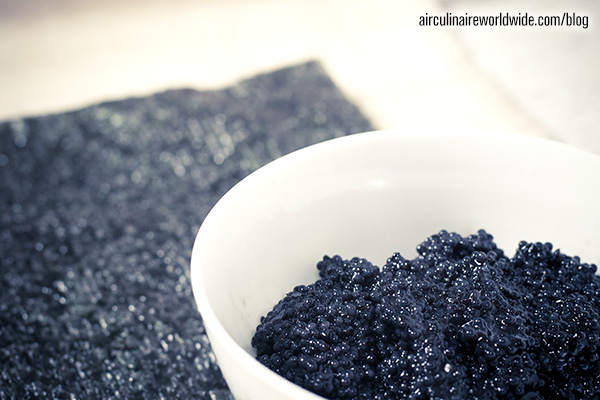A common question when planning an in-flight caviar service is “How much caviar should I buy for the flight?” There are many factors to consider when purchasing caviar, such as: How many passengers will be on-board? How are you serving the caviar? Are your passengers big caviar eaters?
General Caviar Purchase Guidelines
- About ½ teaspoon, or 8-10 servings per ounce, of caviar if you are only serving a little bit to your passengers.
- For canapes in which caviar is not the main protein or garnish, you can get about 20 servings of ¼ teaspoon per ounce.
- If your passengers are eating straight caviar, consider at least one once per passenger.
- If serving appetizers with caviar, consider about ½ ounce per passenger.
- Knowing your passengers is key to calculating the likely consumption amount of caviar. However, a good rule of thumb is about ½ ounce per person.
Safely Storing Caviar
Keep the caviar sealed until it is needed for service. Once opened, cover and refrigerate the caviar. Use the caviar, once opened, within a day or two. When covering caviar, it best to use plastic wrap directly on top of the caviar before placing it into the refrigerator. Once in the refrigerator, it is a good idea to turn the tin upside-down once a day so the oil can reach all the eggs. Like fine wine, caviar flavors change with age; tins are periodically turned to help develop its flavor and texture.
Be sure to keep the caviar cold. Freezing caviar can be done, but is not recommended for caviar with softer outside membranes – such as Caspian varieties. Freezing can toughen the caviar roe’s membrane and alter the flavor. However, many varieties of American caviar can be frozen and, because of this, can be utilized in recipes where the normal production might have broken the pearls. It is not recommended, but if you cannot consume the caviar within one week and cannot just refrigerate it, then your only option is to freeze it or discard it. When taking it out of the freezer let the caviar thaw slowly before serving.
In order to avoid having the caviar burst, it best to keep it refrigerated at 28 to 32 F (-2 to 0 C). Usually, the meat shelf is the coldest part of the refrigerator, so it is best to keep it there, or you can put the can on crushed ice. Fresh, unopened caviar can be stored in a refrigerator for 15 to 20 days. However, caviar must be consumed within 2-3 days once it has been opened. Unopened, pasteurized caviar has a six month shelf-life.
Handling, Etiquette and Serving
Handling caviar can be difficult, so be very gentle with it. When lifting the caviar out of the tin, use a non-metallic spoon. A metallic spoon will alter the flavor. Use the spoon to lift up the caviar, careful to not burst the pearls. Caviar spoons should be made of bone or mother of pearl.
Salmon caviar should only be used to decorate canapes or sushi. You can place this type of caviar by using a tip of a knife, if necessary. Never use dyed caviar since these are usually lower in quality and taste. Before serving caviar, remove it from the refrigerator 10 to 15 minutes before serving.
Caviar always goes well with champagne, vodka and some dry white wine. Other drinks may alter the flavor, and your passengers may not get the full flavors out of the caviar.
Questions?
If you have any questions about this article or in-flight catering, contact weborders@airculinaire.com.





